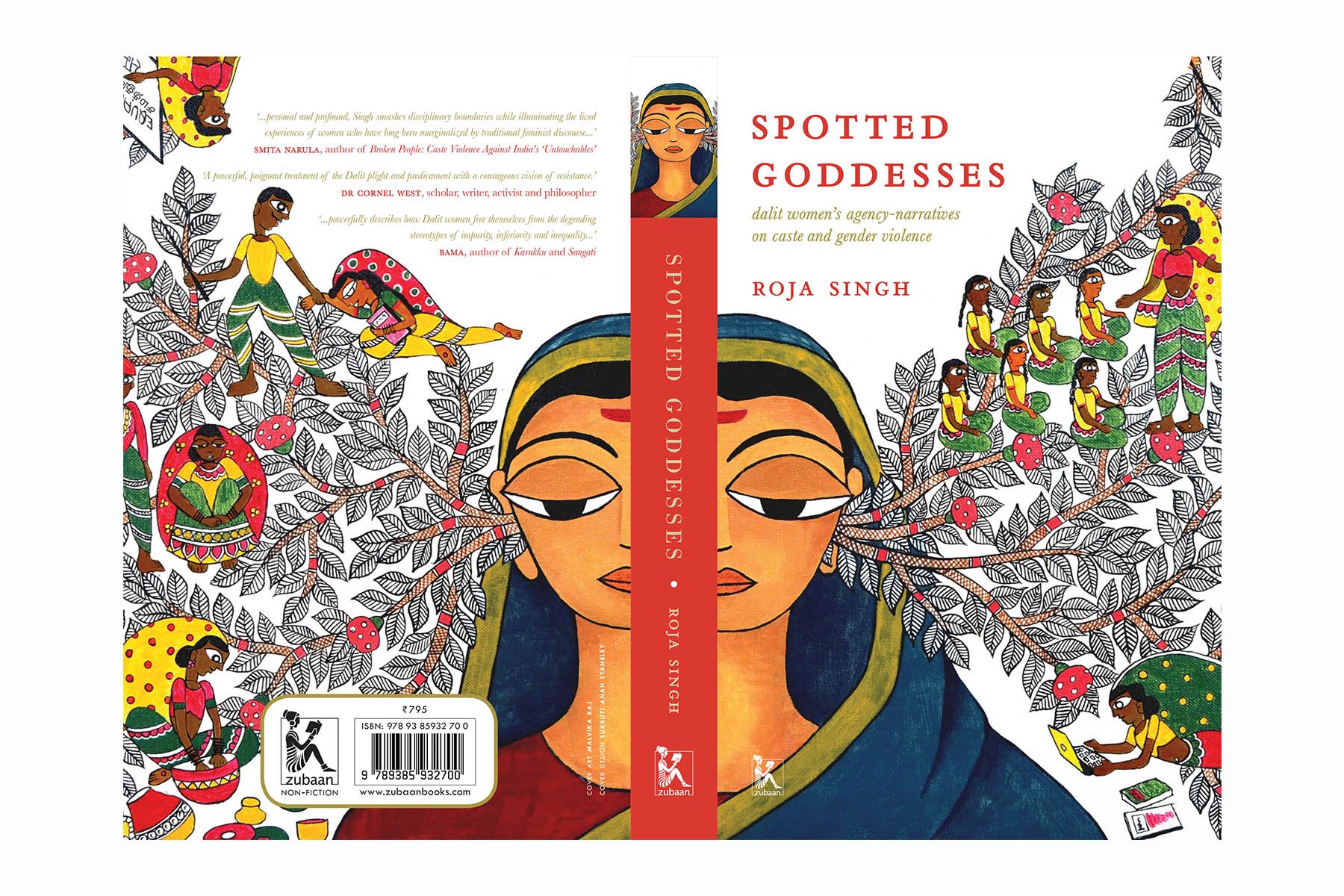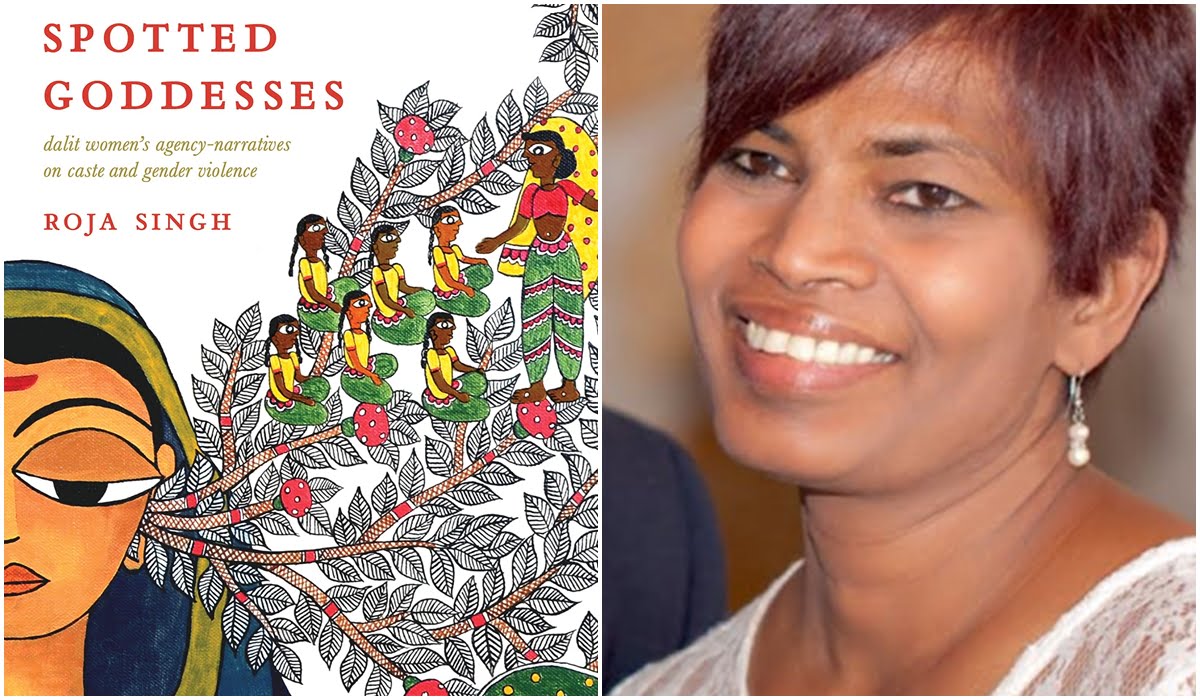The book Spotted Goddesses: Dalit Women’s Agency-Narratives on Caste and Gender Violence (2019) by Roja Singh is an ethnography that aims to present the Dalit women activists’ narratives as spotted goddesses from the Dalit community in the Pudukkottai district in Tamil Nadu. These spotted goddesses assert their identities as Dalit women with heterogeneous experiences that resist the violence and oppression inflicted upon them by the caste communities and Dalit men. Roja Singh presents the Dalit women-their experiences and resilience within the framework of transnational feminism, Earthy Humanness, and ‘difference’ in Spotted Goddesses. The author adapts to the term ‘difference,’ highlighting the lived experiential realities of Dalit women engaging in ‘different’ places and culture while rejecting any imposed and shameful identity with their experiential knowledge.
Roja Singh presents the Dalit women-their experiences and resilience within the framework of transnational feminism, Earthy Humanness, and ‘difference’ in Spotted Goddesses.
Also read: Book Review: Fierce Femmes And Notorious Liars By Kai Cheng Thom
The two protagonists Kalaimagal and Rani are the spotted goddesses, and the book traces their journey of resistance against caste and gender-based violence and state-sponsored structural oppression against the Dalit community that affects the Dalit women the most. The author attempts to present fragile, passionate, responsible, responsive, and hopeful voices in the form of resistance and activism. She describes them as active-agents in change-making, sustaining culture, and strengthening relationships. Spotted Goddesses’ objective is to challenge and reconstruct the ‘differences’ of the Dalit women from the aspect of Earthy Humanness that challenges the normalised ignorance towards the earthy subversive voices by categorising them as ‘silenced’ or ‘subaltern’.
The book constitutes the oral history of Mariamma (a Dalit goddess), the critique of the mythological representation of the Rakshasa women (non-caste Hindu women), and the oral narratives of the Dalit women leaders. The author delineates on Hindu social order scripted in Manusmriti and the mythological establishments within Hindu epics such as Ramayana and Mahabharata and the representation of Soorpankha in the former one and Hidimva in the latter one.
The Dalit women remain stagnant within the category of pollution that pushes them into exile due to their polluted bodies. Furthermore, it makes them more vulnerable to violence and oppression. The author highlights the embodiment of sexual and physical violence of Dalit women by the Caste men and Dalit men to sustain caste and gender-based hierarchy. In chapter 3 of Spotted Goddesses, the author discusses the “othering‟ of the non-Hindu women and their portrayal. The Rakshasa women, Soorpankha and Hidimva, are portrayed with undesirable bodies, possessed with savage lust and masculine strength. Singh delineates the desirability of the Rakshasa women and Dalit women who go through internalised anxiety due to the Brahmanical conceptualisation of beauty and desirability.
Soorpankha got her nose mutilated for expressing her anger as a reaction towards her humiliation by the Caste men. Hidimba gets involved with a Caste man and killed by her indigenous men, and both attempt to transgress their boundaries. Singh presents a theoretical critique of the presentations of Dalit and indigenous women in Hindu culture. The oral narratives present the resilience against structural oppression and violence, and these narratives reject the Dalit women’s victimisation with no agency.
Chapter 4 of Spotted Goddesses presents a historical account of the violence against Dalit women in Pudukkottai district of Tamil Nadu, in which Dalit women’s agency has deeply-seated characteristics of all human beings that desire, seek and demand dignity. Yet, Dalit people have attempted to and are unable to access these specific and fundamental human rights. Singh presents the historical account of Dr. Awards, an organisation founded in 1995 to claim their rights as Dalit women in the society and to seek justice. It also aims to eradicate manual scavenging and claims that Dalit communities are self-sustaining as a community.

Dalit women and girl children are vulnerable to certain forms of violence, regardless of their labors. In Pudukkottai, 71 percent of the Dalit community population is immensely diverse and categorised through occupations. The Dalit women were majorly involved in stone quarries, building sites, and selling cow dung. The work in stone quarries involves occupational hazards such as tuberculosis. Dalit communities continue to face illiteracy, poverty, sexual-violence, institutional oppression in a democracy. The author strikes the aspect of victimisation and resistance through the narratives collected through interviews of Janaki, Chithra, Renuka, and Vijaya. These excerpts in Spotted Goddesses hold instances of sexual-violence over Dalit women by coercive forces that include Caste men and Dalit men. Dalit women face social and economic marginalisation; they got left with no choice but submission, by accepting and obeying the caste and gender-based social norms. Dalit women are positioned on such vulnerable edges that they risk their lives when they stand against these coercive forces. Singh proceeds with the journeys of Kalai and Rani with experience, response, strategies, access, networking, and an immense amount of work for the benevolence of their community by eradicating social norms and violence.
These excerpts in Spotted Goddesses hold instances of sexual-violence over Dalit women by coercive forces that include Caste men and Dalit men.
Like Savitribai Phule and Dr B R Ambedkbar, Kalaimagal and Rani also became the symbol of “educated” and “empowered” figures through asserting their Dalit identities and regaining consciousness to identify and resist the structural oppression. Singh dedicated two chapters (Chapter 5 and 6) to their journey towards social justice and fought against a historically embedded and structural oppression and violence they had to face as a consequence of it. These chapters in Spotted Goddesses contextualised in the present context of Kalaimagal and Rani in Pudukkottai district of Tamil Nadu through which Singh proceeds with the experiential journey of resilience and Dalit assertion.
Also read: Book Review: These Hills Called Home: Stories From A War Zone By Temsula Ao
Singh presents both of them as the Earthy Humans belonging to the oppressed category of the “other”, with brutal experience of caste-based violence and some socio-political aspects of enmity and threat to life and body. Since the beginning and the end, Singh consistently highlighted the emphasis over formal education within the Dalit Movement. Singh brings attention to Kalai’s agency and activism in Spotted Goddesses that involves a humanist approach based on the strong intersection between their individual and communal experiences of violence. Kalai aims to strengthen collective desires from the standpoints of both women and Dalit identities. Singh attempts to dwell upon these Dalit women’s everyday lives and their expression of experience, remorse, agony, love, and affection through songs and customs.
In chapter 7 of Spotted Goddesses Singh presents Dalit women and their everyday experiences as songs depicted as the earthy expressions of Dalit culture, identity, subversive assertion and affirmation of relationships and the movement that dwells within the earthy lived experience of Dalits. Through these songs, the Dalit women draw us into celebratory spaces of positive identities and into the spaces of resistance to all the coercive forces that attempt to crush them. Altogether, the book revolves around the Dalit women’s unheard experiences living under a high degree of vulnerabilities and the possibility of violence and oppression. The author highlights the voices, narratives, and the experiences of Dalit women. Methodologically, Spotted Goddesses attempts to highlight the academic process of homogenising representation and “othering” through ‘difference’.
Spotted Goddesses is a holistic treat for readers to understand the intricacies and struggles of Dalit women fighting within and outside their communities.
The book uses sensory ethnography, reflexivity of the author herself, and successfully attempts to present the oral history and theorises the experience within the academic discourse. Singh explicitly positioned herself within her identity as a Dalit writer and explored her roots through the oral experiences of the two protagonists and other Dalit women. Hence, Spotted Goddesses is a holistic treat for readers to understand the intricacies and struggles of Dalit women fighting within and outside their communities.
Rashmi Kumar is currently enrolled with the PhD programme in Sociology at the Department of Humanities and Social sciences, IIT Delhi. Her research interests include intersectionalities of gender, sexualities and caste in urban spaces. She has also worked with Zubaan publishing house, and has done fieldwork in the cities of Thane, Ahmedabad, and Guwahati. She has completed her masters in sociology from Pondicherry University. She can be found on Facebook and Instagram.





Hi, I have a request. Can you please review Indira meshram’s ‘How I achieved real success – A happiness guide for modern women’ book. She is praised by MRAs. They are even publishing her interviews. I don’t know what’s so special about it. I would love to know what feminists in FII think about it. Please accept my request.
I have been following your social media handle and you guys are doing well. Keep it up.